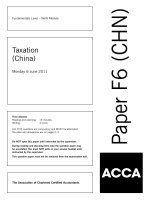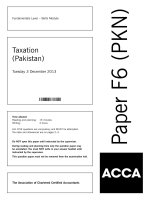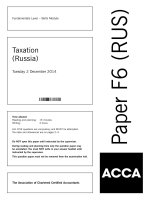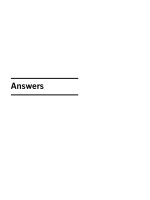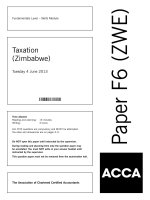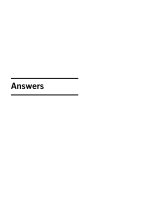ACCA f6 taxation south africa 2015 jun question
Bạn đang xem bản rút gọn của tài liệu. Xem và tải ngay bản đầy đủ của tài liệu tại đây (304.84 KB, 15 trang )
Taxation
(South Africa)
Tuesday 2 June 2015
Time allowed
Reading and planning:
Writing:
15 minutes
3 hours
This paper is divided into two sections:
Section A – ALL 15 questions are compulsory and MUST be attempted
Section B – ALL SIX questions are compulsory and MUST be attempted
Tax rates and allowances are on pages 2–5.
Do NOT open this paper until instructed by the supervisor.
During reading and planning time only the question paper may be
annotated. You must NOT write in your answer booklet until instructed
by the supervisor.
Do NOT record any of your answers on the exam paper.
This question paper must not be removed from the examination hall.
The Association of Chartered Certified Accountants
Paper F6 (ZAF)
Fundamentals Level – Skills Module
SUPPLEMENTARY INSTRUCTIONS
1.
2.
3.
Calculations and workings need only be made to the nearest R.
All apportionments should be made to the nearest month.
All workings should be shown in Section B.
TAX RATES AND ALLOWANCES
The following tax rates and allowances are to be used in answering the questions.
Year ending 28 February 2015/31 March 2015
Rebates
Primary rebate
Secondary rebate (over 65)
Tertiary rebate (over 75)
R12,726
R7,110
R2,367
Interest exemption
Under 65
Over 65
R23,800
R34,500
Foreign dividend exemptions
Fully exempt where 10% or more of the equity shares and voting rights are held.
Fully exempt where received by a company from a foreign company resident in the same country as the recipient.
To the extent of any controlled foreign company inclusions (net of applicable foreign tax)
To the extent that the foreign dividend is from a company listed on the JSE
To the extent that the above do not apply:
For individuals 25/40ths of the dividend is exempt
For companies 13/28ths of the divided is exempt
Medical aid contribution tax rebate rates
Single member
Member plus one dependant
Each subsequent dependant
R257
R514
R172
Additional medical expenses tax rebate
Persons 65 or older or persons younger than 65 if that person, their spouse or their child is a person with a
disability:
((Medical contributions – (medical aid contribution tax rebate x 3) + other qualifying medical expenses) x 33·3%
Persons younger than 65:
((Medical contributions – (medical aid contribution tax rebate x 4) + other qualifying medical expenses) as
exceeds 7·5% of taxable income x 25%
Dividends tax
15%
Companies
Normal tax rate
28%
Official rate of interest (assumed)
8%
2
Rates of normal tax payable by persons (other than companies)
for the year of assessment ended 28 February 2015
Where the taxable income:
does not exceed R174,550
exceeds R174,550 but does
exceeds R272,700 but does
exceeds R377,450 but does
exceeds R528,000 but does
exceeds R673,100
not
not
not
not
exceed
exceed
exceed
exceed
R272,700
R377,450
R528,000
R673,100
18% of each R1 of the taxable income
R31,419 plus 25% of the amount over R174,550
R55,957 plus 30% of the amount over R272,700
R87,382 plus 35% of the amount over R377,450
R140,074 plus 38% of the amount over R528,000
R195,212 plus 40% of the amount over R673,100
Tax rates for small business corporations
for the year of assessment ended 31 March 2015
Where taxable income:
does not exceed R70,700
exceeds R70,700 but does not exceed R365,000
exceeds R365,000 but does not exceed R550,000
exceeds R550,000
Nil
7% of the amount over R70,700
R20,601 plus 21% of the amount over R365,000
R59,451 plus 28% of the amount over R550,000
Turnover tax rates for micro businesses
for the year of assessment ended 28 February 2015
Where taxable turnover:
does not exceed R150,000
exceeds R150,000 but does
exceeds R300,000 but does
exceeds R500,000 but does
exceeds R750,000 but does
not
not
not
not
exceed
exceed
exceed
exceed
R300,000
R500,000
R750,000
R1,000,000
Nil
1% of the amount over R150,000
R1,500 plus 2% of the amount over R300,000
R5,500 plus 4% of the amount over R500,000
R15,500 plus 6% of the amount over R750,000
Car allowance
Maximum vehicle cost for actual expenses
R560,000
Fringe benefit (company car)
Benefit percentage (where no maintenance plan exists)
3·5%
Benefit percentage (where a maintenance plan exists)
3·25%
General business reduction: Benefit value x business kms/total kms (as per logbook)
Private fuel reduction: Private fuel (R) x private kms/total kms (as per logbook)
Private maintenance reduction: Private maintenance (R) x private kms/total kms (as per logbook)
Subsistence allowances
Deemed expenditure for meals and incidental costs (per Government regulation) R335 per day (local travel)
Deemed expenditure for incidental costs only (per Government regulation) R103 per day (local travel)
Deemed expenditure for meals and incidental costs (foreign travel) – (per published tables) will be supplied in
the question where relevant
3
[P.T.O.
Common capital allowances
New and unused manufacturing plant and equipment
Used or leased manufacturing plant and equipment
40%/20%/20%/20%
20% each year for five tax years
New or unused plant or machinery used for research
and development (where it does not qualify for the
research and development accelerated allowance)
Small business corporation manufacturing plant and equipment
Small business corporation (other assets) – unless wear and tear
provides a greater deduction
50%/30%/20%
100%
50%/30%/20%
Wear and tear (based on Binding General Ruling 7) will be supplied in the question where relevant
Manufacturing building allowance (unless seller’s rate supplied)
New or unused commercial building (not a manufacturing building)
– No deduction where another section of the Act applies to the building
– Where part of a building is acquired, 55% of the acquisition price is ‘cost’
– Where an improvement to the building is acquired, 30% of the acquisition price
of the improvement is ‘cost’
Research and development (R&D) expenditure
5%
5%
150%
Costs related to immovable property, machinery, plant, implements, utensils or
articles (excluding any prototype or pilot plant created solely for the purpose of the
process of research and development) are not claimed as research and development
expenditure. Financing, and administrative or compliance costs may not be claimed
as research and development expenditure.
Capital gains tax
Annual exclusion (while alive)
R30,000
Annual exclusion (in year of death)
R300,000
Primary residence exclusion
R2,000,000
(where proceeds are R2 million or less, the full gain is excluded for the portion of the property used for
domestic purposes as a primary residence)
Inclusion rate (natural persons)
33·3%
Inclusion rate (non-natural persons)
66·6%
Time apportioned base cost formulae:
Y = B + [(P – B) x N]/(T + N)
P = R x B/(B + A)
Where deductible enhancement expenditure has been incurred after the valuation date, the time apportioned
base cost formulae change to:
Y = B + [(P1 – B1) x N]/(T + N)
P1 = R1 x B1/(A1 + B1)
4
Travel allowance table
for years of assessment commencing on or after 1 March 2014
Value of the vehicle (including value
added tax (VAT) but excluding
finance charges or interest)
R
0 – 80,000
80,001 – 160,000
160,001 – 240,000
240,001 – 320,000
320,001 – 400,000
400,001 – 480,000
480,001 – 560,000
Exceeds 560,000
Fixed cost
Fuel cost
Maintenance
cost
R p.a.
25,946
46,203
66,530
84,351
102,233
120,997
139,760
139,760
c/km
92·3
103·1
112·0
120·5
128·9
147·9
152·9
152·9
c/km
27·6
34·6
38·1
41·6
48·8
57·3
71·3
71·3
Note: Where reimbursement is based on actual business kilometres travelled and no other compensation is paid
to such employees and the kilometres travelled for business does not exceed 8,000, the prescribed rate is R3·30
per kilometre.
5
[P.T.O.
Section A – ALL 15 questions are compulsory and MUST be attempted
Please use the grid provided on page two of the Candidate Answer Booklet to record your answers to each multiple
choice question. Do not write out the answers to the MCQs on the lined pages of the answer booklet.
Each question is worth 2 marks.
1
In relation to direct and indirect tax, which of the following statements is true?
A
B
C
D
2
Income tax is an example of an indirect tax and value added tax an example of a direct tax
Both income tax and value added tax are examples of direct taxes
Income tax is an example of a direct tax and value added tax an example of an indirect tax
Both income tax and value added tax are examples of indirect taxes
Jacob, a South African tax resident aged 62, received the following foreign investment income during the year of
assessment ended 28 February 2015:
(1) A dividend of R60,000 from a foreign company in which he holds 11% of the equity share capital and voting
rights
(2) A dividend of R5,000 from a holding in a company listed on the Johannesburg Stock Exchange (JSE) and the
London Stock Exchange (LSE)
(3) Other foreign dividends of R15,000
(4) Foreign interest of R24,000
What is the amount which will be included in Jacob’s taxable income in the 2015 year of assessment?
A
B
C
D
3
R54,000
R36,500
R5,825
R29,625
Alice received the use of a company car from her employer company on 1 March 2014. Company policy requires her
to pay for all private fuel based on the logbook. The Commissioner for the South African Revenue Service accepts that
accurate records are maintained for travel. The company acquired the car for cash of R489,970 (including value
added tax) and the car came with a five-year maintenance plan. For the year of assessment ended 28 February 2015,
Alice travelled 35,000 km in total, of which 12,000 km were for private travel.
What is the amount of the assessable benefit to be included in Alice’s taxable income for the 2015 year of
assessment?
A
B
C
D
4
R52,208
R39,722
R162,767
R47,168
A taxpayer, who is non-resident in South Africa for income tax purposes, is only subject to capital gains tax on certain
assets.
Which of the following assets are subject to capital gains tax if disposed of by a non-resident taxpayer?
A
B
C
D
Only immovable property (including interests in immovable property) in or assets of a permanent establishment
in South Africa
Any assets situated in South Africa
Assets of any type, wherever located
As the taxpayer is not tax resident, they are not subject to capital gains tax in South Africa on any asset disposals
6
5
Joe’s Traders (Pty) Ltd is a value added tax (VAT) vendor which files monthly VAT returns. Joe’s Traders (Pty) Ltd
acquired second-hand goods (not fixed property) from a VAT vendor for a VAT-inclusive consideration of R57,000.
The open market value of the goods at the time of purchase was R54,000. The payment agreement stipulated that
an initial payment of R23,500 be made on conclusion of the contract in May 2015 and the balance be paid within
30 days of delivery in June 2015. A tax invoice was issued in May 2015.
What is the amount of VAT input which may be claimed by Joe’s Traders (Pty) Ltd in May 2015?
A
B
C
D
6
R7,000
R6,632
R2,886
R3,316
ENG Consulting (Pty) Ltd has one shareholder and one employee, an engineer, Mr Clem Eng, who provides
consultancy services for construction projects. Clem is currently engaged in a large consulting project which will last
for 13 months. The maximum turnover the company generates is R950,000.
As which entity type will ENG Consulting (Pty) Ltd be taxed?
A
B
C
D
7
Sole proprietorship
Micro business
Standard company
Partnership
ABC Ltd is a company incorporated in South Africa. With effect from 1 September 2014, the company moved its place
of effective management to Country X. Country X deems ABC Ltd to be tax resident in terms of its domestic law. The
double tax treaty between Country X and South Africa deems a dual resident company to be classified as resident in
the country in which the place of effective management takes place.
For what period of the year of assessment ending 31 March 2015 is ABC Ltd a tax resident of South Africa?
A
B
C
D
8
The entire 2015 year of assessment
None of the 2015 year of assessment
1 April 2014 to 31 August 2014
1 September 2014 to 31 March 2015
The Tax Administration Act permits complaints against a tax practitioner to be raised with the tax practitioner’s
controlling body by certain bodies.
Which of the following person(s) is always permitted to raise a complaint against a registered tax practitioner?
(1)
(2)
(3)
(4)
The
Any
Any
The
Commissioner of the South African Revenue Service (SARS)
other senior SARS official
SARS assessor
taxpayer client
A
B
C
D
1 only
1 and 2
2 and 3
4
7
[P.T.O.
9
XYZ Ltd is a South African resident company. XYZ Ltd has just submitted its tax return for the year of assessment
ended 31 March 2014 but has not yet been assessed. The 2014 submitted return showed taxable income of
R6,300,000 including a taxable capital gain of R150,000.
XYZ Ltd’s tax assessment for the year ended 31 March 2013 showed taxable income of R5,600,000 including a
taxable capital gain of R300,000. The company’s revenues are increasing and so a low estimate would be
inappropriate.
What is the amount of estimated taxable income to be used by XYZ Ltd in calculating its first provisional tax
payment for the 2015 year of assessment?
A
B
C
D
R6,148,000
R6,300,000
R6,150,000
R5,600,000
10 GenPlus Ltd provided a company car to its managing director. The car cost R675,000 including value added tax (VAT)
when purchased by GenPlus Ltd on 1 July 2014. GenPlus Ltd is a VAT vendor which makes only taxable supplies
and files its VAT returns every two months. The car came with a five-year maintenance plan and GenPlus Ltd bears
all fuel costs.
What is the output VAT on the car benefit to be included in each of GenPlus Ltd’s two-monthly VAT returns?
A
B
C
D
R248
R436
R497
R994
11 Jennifer (aged 42) was sent temporarily to an office outside South Africa by her South African resident employer.
Jennifer spent eight months working at the overseas office during the year of assessment ended 28 February 2015.
Jennifer earns a salary of R400,000 per annum. During her time away from South Africa, she earned a further
monthly allowance of R75,000 (this was not a subsistence allowance). She earned interest from a South African bank
of R28,000 during the year of assessment.
What is the amount of Jennifer’s taxable income for the 2015 year of assessment?
A
B
C
D
R137,533
R1,004,200
R337,533
R342,667
12 Small (Pty) Ltd is a small business corporation. During the year of assessment ended 31 March 2015, it acquired an
asset used for manufacturing purposes for R50,000, office furniture for R23,000 and desktop computer software for
R5,000. The Commissioner for SARS accepts a write-off period of six years for office furniture and two years for
desktop computer software. All figures are stated exclusive of value added tax.
What is the maximum amount of capital allowances which Small (Pty) Ltd may claim in respect of the above
acquisitions in the 2015 year of assessment?
A
B
C
D
R78,000
R66,500
R56,333
R64,000
8
13 Listed Ltd pays a cash dividend to its two shareholders, being a resident company and a non-resident company. The
resident company holds 40% of Listed Ltd’s equity share capital and the non-resident company holds the remaining
60%.
In relation to the dividends paid by Listed Ltd, which of the following statements are true?
(1) The dividend paid to the resident company is exempt from withholding tax
(2) The dividend paid to the non-resident company is exempt from withholding tax as it holds more than 10% of
Listed Ltd’s equity shares
(3) The dividend paid to the non-resident company is subject to a 15% dividends withholding tax
(4) The dividend paid to the resident company is subject to a 15% dividends withholding tax
A
B
C
D
3
1
2
1
and
and
and
and
4
2
4
3
14 During the year of assessment ended 28 February 2015, Desmond disposed of the following assets:
–
–
–
His motor car realising a capital gain of R50,000. Desmond had received a travel allowance from his employer
in respect of the car which was used 50% of the time for business purposes
His primary residence. The sale price was R1,900,000 and the base cost was R1,500,000. Desmond had used
10% of the space in his residence for business purposes
His 12-metre yacht realising a gain of R20,000
Desmond has already used his annual exclusion against other disposals.
What is Desmond’s aggregate capital gain in respect of the above disposals?
A
B
C
D
R60,000
R0
R20,000
R40,000
15 Park Vend Ltd is a registered value added tax (VAT) vendor. The company supplies and manages a coin-operated
machine for a car park. The machine issues customers with a ticket on entrance to the car park and then collects the
relevant money (based on the time spent in the car park) from the customer on exit.
A VAT vendor customer used the car park whilst he attended a business meeting. On exit from the car park, the
customer is required to pay R30 for the time spent in the car park and a receipt (also a tax invoice) is issued by the
machine. Park Vend Ltd collects the money from the machine every two months.
When does the time of supply for VAT purposes occur for Park Vend Ltd in respect of the above transaction?
A
B
C
D
On the issue of the ticket by the machine on the customer’s arrival
On the R30 of coins entering the machine in payment on the customer’s exit
When the machine issues the tax invoice (receipt) on the customer’s exit
When Park Vend Ltd eventually collects the money from the machine
(30 marks)
9
[P.T.O.
Section B – ALL SIX questions are compulsory and MUST be attempted
Please write your answers to all parts of these questions on the lined pages within the Candidate Answer Booklet.
1
Joseph Anybody emigrated from South Africa on 1 July 2007. He is a very wealthy individual and has a successful
furniture business in the United Kingdom. As Joseph preferred the South African summer to the United Kingdom
winter, he still comes to South Africa for regular long holidays, but with no intention of returning on a permanent basis.
Over the past few years he has spent the following time in South Africa (including the date of arrival and departure):
Year of assessment
2009
2010
2011
2012
2013
2014
Days in South Africa
89
94
105
120
92
97
Joseph has spent 96 days in South Africa in the 2015 year of assessment.
On 19 October 2011, Joseph purchased a plot of land in South Africa for R4,000,000 overlooking the ocean on
which he originally intended to build a holiday house.
However, Joseph then identified an opportunity to build a secure complex of two houses with a common secure
boundary on his plot of land with the hope of selling it on at a large profit. He decided to actively pursue this
opportunity on 15 September 2014, at which point the vacant land had a market value of R5,050,000. Joseph
subsequently carried out significant additional work to sub-divide the land, prepare the plot and to design and build
the common boundary with electric fencing in order to maximise the profit.
Joseph’s commercial marketing has identified potential buyers for the houses but the sales are only anticipated to take
place in the 2016 year of assessment.
Required:
(a) Explain whether or not Joseph will be considered to be a resident of South Africa for income tax purposes
for the 2015 year of assessment.
(6 marks)
(b) Explain why a capital gains tax event may arise for Joseph in the 2015 year of assessment notwithstanding
that no actual sales take place.
(2 marks)
(c) Calculate Joseph’s aggregate capital gain for the 2015 year of assessment, assuming that a capital gains tax
event is triggered.
(2 marks)
(10 marks)
10
2
Judy Ltd, a newly incorporated company, has an opportunity to run a number of coin-operated laundry machines
across four different apartment complexes. The turnover from this operation is anticipated to be around R350,400 in
the first year. The machines will each cost R30,000 exclusive of value added tax (VAT) from a VAT vendor and it is
anticipated that the company will need to buy 24 machines.
The residents of the complex, none of whom are VAT vendors, will make use of the machines, which will be available
24 hours a day. The machines have an expected life of ten years, but the Commissioner for the South African Revenue
Service (SARS) permits the machines to be written off over five years (with no residual value). Judy Ltd would fund
the purchase of the machines by way of a bank loan at a simple interest rate of 8% per annum. The running costs
for each machine (fully deductible) are anticipated to be R2,000 (excluding VAT) per annum.
Judy Ltd is not yet registered for VAT.
Required:
(a) Advise on the factors which should be considered when deciding whether or not Judy Ltd should register for
VAT.
Note: You should support your answer with appropriate calculations, where relevant.
(5 marks)
The newly appointed finance director of Judy Ltd has decided not to register Judy Ltd for VAT due to the increased
administrative burden this would pose.
Judy Ltd is expected to pay tax at the small business corporation rates. However, the finance director has also heard
of a turnover tax regime and is considering whether it would be tax advantageous to register for this regime.
Required:
(b) Calculate the tax payable by Judy Ltd in the first year of operation if the company registers for the turnover
tax regime.
(1 mark)
(c) Calculate the tax payable by Judy Ltd in the first year of operation if the company does not register for the
turnover tax regime.
(3 marks)
(d) State whether Judy Ltd should register for turnover tax in its first year of operation.
(1 mark)
(10 marks)
11
[P.T.O.
3
Lesley Tulip has run a successful sole proprietorship for the last 20 years. The combined market value of all of her
business assets is less than R10 million.
Lesley became 55 years old on 1 January 2014. Increased competition combined with a desire to retire led her to
enter into the following transactions during the year of assessment 2015:
(i)
Sale of her business premises for R5,500,000 on 1 November 2014. The premises had cost Lesley R4,000,000
when purchased seven years ago when the business changed its location. No capital allowances were claimable
on this building.
(ii) Sale of office furniture for R32,000 on 1 January 2015. The furniture had cost Lesley R80,000 when purchased
six years previously and is fully depreciated for tax purposes.
(iii) Sale of a specialised machine (Machine A) for R160,000 on 15 January 2015. This machine originally cost
Lesley R150,000 when purchased on 1 March 2013 and had a tax value of R125,000 at the date of sale.
Machine A was purchased to replace Machine Z which was sold on 1 March 2013 for proceeds of R120,000.
These proceeds were used to acquire Machine A. Machine Z had originally cost R110,000 and at the date of
sale had a tax value of R95,000.
Both Machine A and Machine Z are depreciated over six years for tax purposes. Lesley elected to roll over the
gain on the disposal of Machine Z against the reinvestment in Machine A in the 2014 year of assessment.
(iv) Lesley also sold her private motor car for R78,000. She bought a new car for R450,000.
Required:
(a) Explain why the exclusion applicable to small business assets will apply to Lesley’s disposals during the
2015 year of assessment and the operation of this relief.
(2 marks)
(b) Calculate Lesley’s aggregate capital gain or loss for the 2015 year of assessment before any reliefs are
claimed.
Note: Provide full workings for any disposal not giving rise to any capital gain or capital loss
(6 marks)
On the advice of her accountant, Lesley has decided to claim the exclusion applicable to small business assets against
all eligible disposals in the 2015 year of assessment.
Required:
(c) State the maximum amount of any future capital gains in respect of which Lesley could claim the small
business asset exclusion and any conditions regarding the timeframe for these future disposals to qualify for
the exclusion.
(2 marks)
(10 marks)
12
4
Roofing Brothers (Pty) Ltd is a value added tax (VAT) vendor company engaged in the replacement of residential roofs.
The following details relate to the company’s transactions during its two-month VAT period, May to June 2015:
(i)
Sales invoiced amounted to R5,700,000.
(ii) Progress payments of R450,000 were received in the period. No tax invoices have yet been issued in respect of
the related services.
(iii) Wages and salaries amounted to R1,500,000.
(iv) A loan from the bank resulted in interest expenses of R45,000 and bank service charges of R375.
(v) A former South African customer, now resident in Botswana, specifically requested Roofing Brothers (Pty) Ltd to
come to Botswana to roof his newly built house. The contract was concluded in Rands and was invoiced as
R1,200,000. Costs incurred in South Africa specifically related to this contract amounted to R950,000.
(vi) Some of the old corrugated iron roofing removed from replaced roofs was sold to a scrap dealer for R15,000.
(vii) The company acquired two vehicles: one is a double cab vehicle for sales personnel to use as a pool car which
cost R489,000 and the second is a large delivery truck for roofing materials which cost R950,000.
All amounts are stated inclusive of VAT, where applicable. Roofing Brothers (Pty) Ltd files all returns electronically.
Required:
(a) Calculate the net VAT payable by Roofing Brothers (Pty) Ltd in respect of the VAT period May to June 2015.
Note: You should indicate by the use of a zero (0) any item listed which has no VAT effect.
(6 marks)
(b) State the date by which Roofing Brothers (Pty) Ltd’s VAT return should be filed with the South African
Revenue Service (SARS) and the date by which payment of the VAT calculated in part (a) should be made.
(1 mark)
(c) List SIX items which should be included on a tax invoice issued by a VAT vendor in order for it to be valid.
(3 marks)
(10 marks)
13
[P.T.O.
5
Charles Dlamini, a young entrepreneur, operates a successful clothing retail shop in partnership with Edward. The
partnership agreement stipulates that profits and losses are shared in proportion to their current capital contribution
(being 60% in the case of Charles and 40% in the case of Edward). The partnership is a registered value added tax
(VAT) vendor.
In the 2014 year of assessment, another partner, James, retired from the partnership. Prior to James’s retirement, the
partnership profits and losses had been shared in the proportions Charles 50%, Edward 30% and James 20%. On
James’s retirement, Charles and Edward had each purchased a 10% interest in the partnership from James.
The financial records for the period 1 March 2014 to 28 February 2015 show the following:
Notes
Sales of clothing
Cost of sales
Interest earned on surplus cash
Bad debts recovered
Administration expenses
Salaries
Interest on capital accounts
Retirement annuity contributions
Depreciation on shop fittings and office furniture
1
2
3
4
5
Net profit
R
8,400,000
(2,800,000)
25,000
12,000
(320,000)
(3,000,000)
(50,000)
(150,000)
(650,000)
––––––––––
1,467,000
––––––––––
All amounts are stated exclusive of VAT, where applicable.
Notes:
1
The bad debt recovered relates to a debt written off as irrecoverable in the 2013 year of assessment.
2
Salaries comprise R1,000,000 paid to each of Charles and Edward and R1,000,000 paid to the remaining
employees.
3
Interest is paid on the partners’ capital accounts in proportion to their capital investment.
4
The partnership contributes R100,000 per annum to a retirement annuity fund for Charles and R50,000 per
annum to a retirement annuity fund for Edward.
5
The depreciation recorded is based on the accounting records. The non-current assets owned by the partnership
are as follows:
–
Shop fittings (held the entire year) originally purchased for R2,400,000.
–
Office furniture acquired on 1 June 2014 including a boardroom table and chairs costing R120,000 and
minor furnishings for the office of R30,000 (the highest priced individual item in this category cost R6,000).
–
New shop fittings acquired on 1 April 2014 for R1,800,000.
The Commissioner for the South African Revenue Service (SARS) permits shop fittings and office furniture to be
depreciated over six years for tax purposes.
In addition to his interest in the partnership, Charles earns R40,000 in South African interest from other investments
held. He contributes R7,000 per month to his medical aid scheme in respect of himself, his wife and his two children
(both minors). He also incurred additional medical expenses (not claimable against the scheme) of R45,000 during
the 2015 year of assessment for an injury his son sustained on an overseas school sports tour.
Required:
Calculate the normal tax liability of Charles Dlamini for the year of assessment ended 28 February 2015.
Note: Your calculation of Charles’s taxable income from the partnership should commence with the net partnership
profit figure of R1,467,000.
(15 marks)
14
6
Sun Energy Ltd is a company which specialises in the manufacture and fitting of solar panels as an off-grid system.
Sun Energy Ltd also carries on operations via a foreign branch.
During the 2015 year of assessment, Sun Energy Ltd recorded the following transactions. All amounts are stated
exclusive of value added tax (VAT) where applicable.
(i)
Sales in South Africa of solar systems amounted to R10,500,000.
(ii) A successful outcome in a court case. The case began as a customer claimed that Sun Energy Ltd’s installation
team had caused their roof to collapse due to careless installation of solar panels. The customer lost the case
after evidence that the internal roof structure had been altered after the installation to increase loft space. The
customer was ordered to pay Sun Energy Ltd’s legal costs. Legal costs of R30,000 had been incurred by the
company in the 2014 year of assessment and of R55,000 in the 2015 year of assessment.
(iii) Additional legal costs of R45,000. These costs were incurred in filing patents in respect the solar panels
produced. The patents are to run for a period of ten years. The (non-legal) patent costs were R162,000.
(iv) Development work on a new form of solar panel. This solar panel is 20% more efficient than any other on the
market globally. The Department of Science and Technology has approved the development of this panel as a
research and development project. The development costs incurred by Sun Energy Ltd in the 2015 year of
assessment include:
(a) the salaries of the development team (R250,000);
(b) the machine designed and built to produce the prototypes (R450,000). It is anticipated that this machine
will ultimately be used in the main production process (a process of manufacture) if the solar panel is
successfully developed;
(c) interest (R35,000) on a loan to fund the construction of the above machine.
(v) A new lease agreement. The premises in which Sun Energy Ltd had been operating had become too small. As
no buildings were available for purchase, the company entered into a lease agreement for ten years. The
agreement requires Sun Energy Ltd to pay a premium of R50,000 and to make improvements to the value of
R450,000 to the leased building. The monthly rental payments are R30,000. The lease was signed on 1 July
2014 and the improvements were completed on 1 August 2014 at a total cost of R480,000. The building is
used mainly for the manufacture of components for the solar systems.
(vi) Sale of the old premises. These were sold for R5,000,000 on 1 November 2014. The premises had been
purchased for R3,400,000 and were first brought into use on 1 April 2003.
Sun Energy Ltd has an assessed loss brought forward of R300,000 from the 2014 year of assessment. The foreign
branch recorded a loss from its trading operations of R250,000 in the 2015 year of assessment. Prior to this, the
foreign branch had always been profitable.
Required:
Calculate the taxable income of Sun Energy Ltd for the year of assessment ended 31 March 2015.
Note: Indicate clearly any items of income which are exempt or amounts which are not deductible by the use of a
zero (0) and include a brief explanation of your treatment, where necessary.
(15 marks)
End of Question Paper
15
